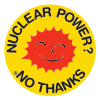
Bataan, officially the Province of Bataan, is a province in the Central Luzon region of the Philippines. Its capital is the city of Balanga while Mariveles is the largest local government unit in the province. Occupying the entire Bataan Peninsula on Luzon, Bataan is bordered by the provinces of Zambales and Pampanga to the north. The peninsula faces the South China Sea to the west and Subic Bay to the north-west, and encloses Manila Bay to the east.

Fidel Valdez Ramos, popularly known as FVR and Eddie Ramos, is a retired Filipino general and politician who served as the 12th president of the Philippines from 1992 to 1998. He is the only career military officer who reached the rank of five-star general/admiral de jure who rose from second lieutenant up to commander-in-chief of the armed forces. During his six years in office, Ramos was widely credited and admired by many for revitalizing and renewing international confidence in the Philippine economy. At age 94, he is currently the oldest living former Philippine president.
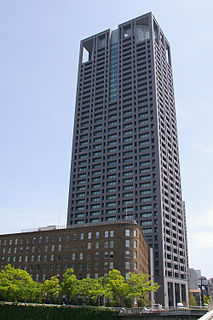
The Kansai Electric Power Co., Inc., also known as Kanden (関電), is an electric utility with its operational area of Kansai region, Japan.

The Bataan Nuclear Power Plant is a nuclear power plant on the Bataan Peninsula, 100 kilometres (62 mi) west of Manila, Philippines. Completed but never fueled, it is located on a 3.57 km2 (1.38 sq mi) government reservation at Napot Point in Morong, Bataan. It was the Philippines' only attempt at building a nuclear power plant. It was mothballed due to safety concerns in the wake of the Chernobyl disaster in Ukraine in 1986 and issues regarding corruption.
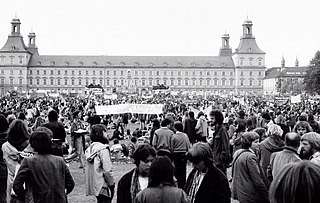
The anti-nuclear movement is a social movement that opposes various nuclear technologies. Some direct action groups, environmental movements, and professional organisations have identified themselves with the movement at the local, national, or international level. Major anti-nuclear groups include Campaign for Nuclear Disarmament, Friends of the Earth, Greenpeace, International Physicians for the Prevention of Nuclear War, Peace Action and the Nuclear Information and Resource Service. The initial objective of the movement was nuclear disarmament, though since the late 1960s opposition has included the use of nuclear power. Many anti-nuclear groups oppose both nuclear power and nuclear weapons. The formation of green parties in the 1970s and 1980s was often a direct result of anti-nuclear politics.
Today,environmental problems in the Philippines include pollution, illegal mining and logging, deforestation, threats to environmental activists, dynamite fishing, landslides, coastal erosion, biodiversity loss, extinction, global warming and climate change. Due to the paucity of extant documents, a complete history of land use in the archipelago remains unwritten. However, relevant data shows destructive land use increased significantly in the eighteenth century when Spanish colonialism enhanced its extraction of the archipelago's resources for the early modern global market. The Philippines is projected to be one of the most vulnerable countries to the impacts of climate change. Meanwhile, the country is projected to be one of the most vulnerable countries to the impacts of climate change, which would exacerbate these weather extremes. As The Philippines lies on the Pacific Ring of Fire, it is prone to natural disasters, like earthquakes, typhoons, and volcanic eruptions. In 2021, the Philippines ranked the fourth most affected country from "weather-related loss events", partly due to the close proximity of major infrastructure and residential areas to the coast and unreliable government support. One of the most devastating typhoons to hit the archipelago was Typhoon Haiyan, known locally as Yolanda, in 2013 that killed 6,300 people and left 28,689 injured. Philippine politicians have demonstrated awareness of environmental crises with the passing of policies like The Clean Air Act of 1999, the Philippine Clean Water Act of 2004, the Climate Change Act of 2009, and participation in the Paris Agreement. However, research has found that outside of cities, the general public doesn't feel equally informed. Environmental activists and land defenders, consisting mostly of Indigenous communities who have been attempting to bring attention to the environmental issues in the country have been met with violence or murder. As a result, the Philippines has been ranked one of the most dangerous places in the world for environmental activists.

Jose Wright Diokno, also known as "Ka Pepe", was a Filipino nationalist, lawyer, and politician. Regarded as the "Father of Human Rights Advocacy in the Philippines", he served as Senator of the Philippines, Secretary of Justice, founding chair of the Commission on Human Rights, and founder of the Free Legal Assistance Group (FLAG), the premier group of Filipino human rights lawyers. Diokno is the only person to top both the Philippine Bar Examination and the board exam for Certified Public Accountants (CPA). His career was dedicated to the promotion of human rights, the defense of Philippine sovereignty, and the enactment of pro-Filipino economic legislation.
Korea Hydro & Nuclear Power is a subsidiary of the Korea Electric Power Corporation (KEPCO). It operates large nuclear and hydroelectric plants in South Korea, which are responsible for about 27 percent of the country's electric power.
Korea Electric Power Corporation, better known as KEPCO or Hanjeon, is the largest electric utility in South Korea, responsible for the generation, transmission and distribution of electricity and the development of electric power projects including those in nuclear power, wind power and coal. KEPCO, through its subsidiaries, is responsible for 93% of Korea's electricity generation as of 2011. The South Korean government owns a 51.11% share of KEPCO. Together with its affiliates and subsidiaries, KEPCO has an installed capacity of 65,383 MW. On the 2011 Fortune Global 500 ranking of the world's largest companies, KEPCO was ranked 271. KEPCO is a member of the World Energy Council, the World Nuclear Association and the World Association of Nuclear Operators. As of August 2011, KEPCO possesses an A+ credit rating with Fitch Ratings, while Moody's has assigned KEPCO an A1 stable rating.

Ceferino "Joker" Paz Arroyo Jr. was a Filipino statesman and key figure in the 1986 EDSA People Power Revolution which ousted dictator Ferdinand Marcos. He was a Congressman for Makati from 1992 to 2001 and Senator from 2001 to 2013. Arroyo received various awards and commendations for his significant contributions to the law profession and public service. Among these are the Philippine Bar Association's Most Distinguished Award for Justice as a “man beholden to no one except to his country” and Senate Resolution No. 100 enacted in the 8th Congress citing his invaluable service to the Filipino people. He was also known for being the thriftiest legislator, earning the title of "Scrooge of Congress", as he only had few staff members without bodyguards and did not use his pork barrel funds.
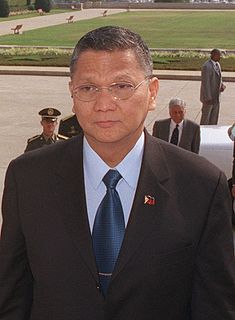
Angelo Tomas Reyes also known as General Reyes, was a Filipino retired general and politician who served as the Armed Forces of the Philippines (AFP) Chief of Staff from 2000 to 2001 under President Joseph Estrada. At the height of the 2001 EDSA Revolution, Reyes withdrew his support for Estrada, which led to the installation of Vice President Gloria Macapagal Arroyo as president, under whom he then served as Cabinet Secretary until 2010. He also served under Arroyo as Secretary of the Departments of the Interior and Local Government, Environment and Natural Resources, Energy, and National Defense.
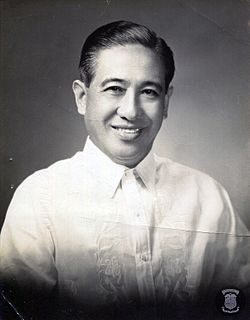
Lorenzo "Ka Tanny" Martinez Tañada Sr. CCLH was a Filipino nationalist, lawyer, solicitor general, senator, national athlete, and human and civil rights defender best known for his many contributions to Philippine nationalism and independence. As first post-war solicitor general, longest serving senator for 24 years, and staunch opposition to martial law under Ferdinand Marcos. He is also equally renowned for his efforts to stop the continued presence of US military bases in the Philippines through the Anti-Bases Coalition (ABC). Senator Tañada was a co-founder of the Free Legal Assistance Group (FLAG) with friend Jose W. Diokno. FLAG is the largest group of human rights lawyers nationwide. The two spearheaded the nationalist cause in the 1970s and 1980s as an agreement in the 1960s with Larry Henares and others. Tañada was also the chairman of the Justice for Aquino, Justice for All (JAJA) movement that sought to oust Marcos after the assassination of former Sen. Ninoy Aquino. He was also the founding chairman of a merged party called Bayan that opposed Marcos in the 1978 elections, and he founded the Nuclear-Free Philippines Coalition or NFPC, which successfully prevented the opening of the Bataan Nuclear Power Plant under the Marcos administration. Serving in the Philippine Senate for 24 years beginning in 1947 up until 1971, he is the longest-serving senator in Philippine history and is referred to as the "Grand Old Man of Philippine Politics."
Anti-nuclear organizations may oppose uranium mining, nuclear power, and/or nuclear weapons. Anti-nuclear groups have undertaken public protests and acts of civil disobedience which have included occupations of nuclear plant sites. Some of the most influential groups in the anti-nuclear movement have had members who were elite scientists, including several Nobel Laureates and many nuclear physicists.

More than 80 anti-nuclear groups are operating, or have operated, in the United States. These include Abalone Alliance, Clamshell Alliance, Greenpeace USA, Institute for Energy and Environmental Research, Musicians United for Safe Energy, Nevada Desert Experience, Nuclear Control Institute, Nuclear Information and Resource Service, Public Citizen Energy Program, Shad Alliance, and the Sierra Club. These are direct action, environmental, health, and public interest organizations who oppose nuclear weapons and/or nuclear power. In 1992, the chairman of the Nuclear Regulatory Commission said that "his agency had been pushed in the right direction on safety issues because of the pleas and protests of nuclear watchdog groups".

Anti-nuclear protests began on a small scale in the U.S. as early as 1946 in response to Operation Crossroads. Large scale anti-nuclear protests first emerged in the mid-1950s in Japan in the wake of the March 1954 Lucky Dragon Incident. August 1955 saw the first meeting of the World Conference against Atomic and Hydrogen Bombs, which had around 3,000 participants from Japan and other nations. Protests began in Britain in the late 1950s and early 1960s. In the United Kingdom, the first Aldermaston March, organised by the Campaign for Nuclear Disarmament, took place in 1958. In 1961, at the height of the Cold War, about 50,000 women brought together by Women Strike for Peace marched in 60 cities in the United States to demonstrate against nuclear weapons. In 1964, Peace Marches in several Australian capital cities featured "Ban the Bomb" placards.

Richard Gordon was the presidential candidate of the Bagumbayan - Volunteers for a New Philippines for the 2010 Philippine presidential elections.
Nuclear power was considered as a solution to the 1973 oil crisis, in which the Philippines was affected. The Bataan Nuclear Power Plant was built in the early 1980s but never went into operation. The Fukushima nuclear disaster gave pause to efforts to revive the plant.
Philippine President Benigno Aquino III has made political position on many national issues.

The politics of New England has long been defined by the region's political and cultural history, demographics, economy, and its loyalty to particular U.S. political parties. Within the politics of the United States, New England is sometimes viewed in terms of a single voting bloc. All of the twenty-one congressional districts in New England are currently represented by Democrats. In the Senate, nine Democrats, two Independents, and one Republican represent New England. The Democratic candidate has won a plurality of votes in every State in New England in every presidential election since 2004, making the region considerably more Democratic than the rest of the nation.

The Philippines is not known, or believed, to possess weapons of mass destruction. Article II Section 8 of the Philippine Constitution explicitly forbids the presence of nuclear weapons in the Philippines.
